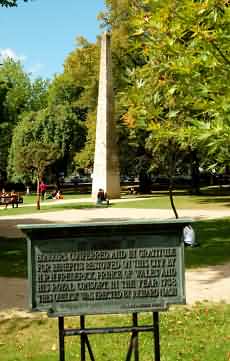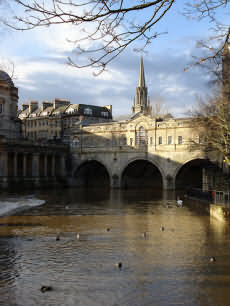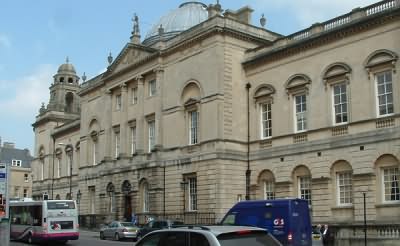 |
| The Local Time is Saturday, 27-Jul-2024 12:13:41 CEST |
Other Places to Visit in Bath |
|
|||
| YOU ARE HERE: Main Home Page > Places to Visit > Bath > Other Places to Visit |
|
|
 |
|
 Victoria Art Gallery - the second most visited museum in Bath  View across Victoria Park towards the Royal Crescent  The American Museum in Britain at Claverton Manor  Priory Park Landscape Garden  Thermae Bath Spa is Britain's original and only natural thermal Spa. |
||||||||||||||||||||||||||||||||||||||||||||||||||||||||
|
||||||||||||||||||||||||||||||||||||||||||||||||||||||||
|
||||||||||||||||||||||||||||||||||||||||||||||||||||||||
Places to VisitThere are many delightful places to visit and explore in the City of Bath, so many in fact, that to do justice to your visit would take several days in getting round them all. Here we list some of the most important places to include in your touring itinerary.
VICTORIA ART GALLERY- Bridge Street, Bath, BA2 4ATThe Victoria Art Gallery is situated at the corner of the Pulteney Bridge this fine Victorian building was built in 1897 to celebrate Queen Victoria’s diamond jubilee. The collection includes works by Gainsborough, Sickert and Zoffany . With a superb collection ranging from the 15th century to the present day the gallery attracts many visitors. Also on show are visiting exhibits, which change on a regular basis. A statue of Queen Victoria is in a niche on the façade of the building; Whilst named after the Queen, the gallery nor Bath was ever visited by her. The Victoria Art Gallery is the second most visited museum in Bath with 1,170,500 visitors a year, the gallery is known for its friendly atmosphere, an exciting and varied programme of exhibitions and stunning permanent collection from Turner and Gainsborough to the moderns. Admission is free. Open throughout the year with the exception of 25th and 26th of December. ROYAL VICTORIA PARKExtending over some 57 acres the park provides many recreational facilities that attract visitors throughout the year. Overlooked by the Royal Crescent (see one of the main pictures above) the park has an obelisk dedicated to the Princess, the foundation stone of this was laid in 1837 and originally had Russian guns captured in the Crimean war nearby, however these have been removed. Within the park there is a Botanical garden that houses many rare species of flora, a boating pond and children’s play area. A bird Aviary is the home to a variety of birds and a Bowling Green, a Putting Green and an area with a Skateboard ramp. 2 Golf courses are also among the superb facilities. It is the venue for the Bath Flower Show, an International Music Festival and Children’s Festival. See also Hot air balloons taking to the skies when weather conditions permit. A Restaurant is on site providing meals and snacks. Parking is available and access can be gained into the park by no less than 7 entrances. BOTANICAL GARDENSThe Botanical Gardens are located within Royal Victoria Park and were formed in 1887. Within their 3.8 hectares (9.5 acres) is one of the finest collections of plants on limestone in the West Country. Less than a mile from Bath City Centre in the north west corner of the Park, the botanical gardens boast many choice trees, shrubs, a fine herbaceous border, a rock garden and pool, a scented walk, a collection of old shrub roses, and a replica of a Roman Temple (the City’s exhibit at the British Empire Exhibition held at Wembley in 1924). These are just a few of the many attractive and interesting features of the garden.
To mark the centenary in 1987 the gardens were extended to include the Great Dell, a disused quarry and formally part of the park itself, which already contained a very fine collection of conifers. It has been developed into a woodland garden, and contains ever more plants and features to add to this fascinating and beautiful park. The Temple of Minerva in the Gardens was carefully adapted and extended in 2009 to create an indoor Interpretation Centre for visitors and schools / groups. The Interpretation Centre has a 15 minute video explaining the restoration of Royal Victoria Park along with other information and occasional exhibitions. The Centre is open during week days only but is available for bookings by schools and groups at other times. QUEEN SQUARE
Throughout the year it plays host to many events which include, Italian Markets, French Markets and an annual Boules tournament , it also a weekend when all the restaurants compete against each other creating much friendly rivalry . The Jane Austen festival in which Promenader’s dressed in 18th century costume parade through the streets of Bath visit the square and are led by the Town Crier and escorted by Soldiers and Sailors . A traditional country fair is held here attracting many visitors. Within the square stands an Obelisk, this records a visit by Frederick Prince of Wales. Erected in 1738 it was paid for by Richard Beau Nash, designed by architect John Wood and built with stone provided by Ralph Allen who owned the quarries that supplied Bath with much of its stone. PULTENEY BRIDGE
Spanning the river Avon it has 3 arches and was designed by Robert Adam with its origins in 1769. The bridge is 1 of only 4 in the world that has shops across its structure on both sides. It took 4 years to complete but suffered severe flood damage some 30 years later in 1799/1800, then the north side needed to be rebuilt, this was done by the senior surveyor to the Pulteney estate John Pinch. During the 19th century alterations to the windows to the shops were carried by the various shopkeepers and in 1936 the bridge was declared a national monument. Restoration work was also been completed in 1951 and 1975 - Now it is a popular shopping area for visitors. PRIOR PARK LANDSCAPE GARDEN- Ralph Allen Drive, Bath, Somerset BA2 5AHThe Palladian mansion which now houses Prior Park College was originally designed and built chiefly by John Wood, the Elder in 1742 as the home for Ralph Allen.
The Palladian bridge and lake that it spans were added in 1755; the final phase with the green slopes from the house to the lake are thought to have been planned by Capability Brown in the 1760s. The garden is set in a sweeping valley where visitors can enjoy magnificent views of Bath. Recent restoration of the 'Wilderness' has reinstated the Serpentine Lake, Cascade and Cabinet. A five-minute walk leads to the Bath Skyline, a six-mile circular route encompassing beautiful woodlands and meadows, an Iron Age hill fort, Roman settlements, 18th-century follies and spectacular views. Important - Prior Park is a green tourism site; there is only disabled car parking (please telephone to book), but public transport runs regularly (every 30 minutes) to and from the park. Please telephone for leaflet or download from the website. Prior Park College, a school, operates from the mansion (not National Trust). The Wilderness and view point are fully accessible. There are steep slopes, steps and uneven paths in the garden. See website for further information and opening times. THERMAE BATH SPA- Hetling Pump Room, Hot Bath Street, Bath BA2 6NH
Thermae Bath Spa (see one of main pictures at top of page) is a remarkable day spa, combining the 'old and new'. The historic spa buildings, the Hot and Cross Baths blend with the contemporary design of the New Royal Bath. Together, they offer bathing in the warm, mineral-rich waters and a range of spa treatments designed to ease the body and soothe the mind. The Spa Visitor Centre depicts the colourful history, culture and traditions that grew round this most famous of Britain's spa towns. The No. 8 shop provides a selection of tempting spa products for you to take home. Whether you are looking for somewhere to meet, eat or simply chat with friends, you can relax and refresh your senses in the inspiring setting of Thermae Bath Spa. Website: www.thermaebathspa.com SYDNEY GARDENS MUNICIPAL PARK- Sydney Road, BATH, BA2 6NTSituated behind the Holburne Museum at the end of Great Pulteney Street, Sydney Gardens is Bath’s oldest park. It was planned and laid out by the architect Harcourt Masters in 1795. 12 acres in size, it became very popular towards the end of the 18th and 19th century and was frequently visited by members of the Royal family and the famous author Jane Austen who lived at number 4 Sydney Place.
The gardens were purchased in 1909 by the city and in the same year a replica of the Temple of Minerva was built to commemorate the Bath Historical Pageant. Today the park contains fine trees, shrubberies, lawns and flower beds, tennis courts and a children’s play area and is popular for its bridge views of the railway line for spotting trains. The Kennet and Avon Canal also runs through the park. It’s wide paths are ideal for cycling along. Another great spot for picnicing, look out for squirrels! There are public toilets and a refreshment kiosk. There is an additional entrance from Holburne Museum of Art which also has tea rooms. Website: www.visitbath.co.uk. No.1 ROYAL CRESCENT MUSEUM- Bath BA1 2LRNo.1 Royal Crescent is a magnificently restored Georgian town house that creates a wonderfully vital picture of life in Georgian Bath. It provides visitors to the Royal Crescent with an opportunity to look beyond the famous Palladian façade and see what life was like for the wealthy in 18th century Bath. Each room is an exquisite example of Georgian interior design with authentic furniture, paintings, textiles and carpets. The superbly appointed Dining Room is set for dessert. Pipes and port are laid out for an evening of cards in the comfortable Gentleman’s Study. Upstairs you can see the elegant Drawing Room, where fashionable visitors took tea, or slip into a delightfully feminine bedroom. Below stairs is a splendidly equipped, bustling Georgian Kitchen.
Guides are in every room with stories of the past and to answer questions. Contact
Tel: +44 (0)1225 428 126,
Fax: +44 (0)1225 481 850. THE GUILD HALL- The Guildhall, High Street, Bath, BA1 5AWThe Guildhall is situated in the very heart of Bath and is an ideal venue for dinners, weddings, meetings and small to medium-sized conferences. It is also home to Bath Council Offices and the Guildhall daily public market.
The Guildhall was built between 1775 and 1778 by Thomas Baldwin to designs by Thomas Warr Attwood. It has been designated as a Grade I listed building. The current building replaced a Stuart Guildhall, built in 1625, which itself replaced an earlier Tudor structure. The facade has 4 Ionic columns and the building is surmounted by the figure of Justice. The central dome was added in 1893. It forms a continuous building with the Victoria Art Gallery and the covered public market. The interior includes a banqueting hall with engaged Corinthian columns. It contains 18th century chandeliers and original royal portraits. The room is used on royal visits to the city including Queen Elizabeth II who had lunch in the banqueting room in May 2002.
The Guildhall is available for hire during the day and in the evening. Its period rooms make it a sought-after venue for filming costume drama. The Scales of Justice statue is positioned at the top of The Guildhall. If you are getting married in the Guildhall, the nearby Parade Gardens provide an excellent location for those important family and friend photos. PARADE GARDENS- Grand Parade Bath, BA2 4DFSituated in the City by the River Avon, overlooking Pulteney bridge and the weir and close to the Abbey. It’s a splendid place to relax in the Summer. You can take a picnic and listen to the music from the bandstand. The floral displays are one of the best in the country. There is a small charge for visitors during the summer.
These delightful gardens are Bath’s most centrally situated and popular pleasure grounds, attracting both tourists and residents. The flower bedding displays are among the finest in the country and the annual 3-dimensional floral feature in the summer is always fun. Concerts are held in the bandstand throughout the summer months and children’s entertainment is provided during the summer holidays. Deck chairs are available. Picnics are allowed but there is also a café with outdoor seating. Parade Gardens is home to the sculptures of King Bladud, Young Mozart and Angel of Peace. Open from Easter to the end of September. There is a small entrance charge to non-Bath residents. ASSEMBLY ROOMS- Bennett Street, Bath, Somerset BA1 2QHThe Bath Assembly Rooms, designed by John Wood the Younger in 1769, are a set of elegant assembly rooms located in the centre of Bath which are now open to the public as a visitor attraction. It has been designated by English Heritage as a grade I listed building.
The 30 metre ballroom is still adorned with the original Whitefriars crystal chandeliers. The rooms house portraits by Gainsborough, Ramsey and Hoare and is made up of four rooms - The Ball Room, The Tea Room,The Octagon and The Card Room. The Card Room can be used as a bar for evening events. The Fashion Museum is also situated within the building, on the lower ground floor, and is home to one of the world’s finest collection of fashionable dress, creating an inspiring venue for any occasion. The Assembly Rooms can be hired for corporate conferences, exhibitions and gala dinners; for wedding ceremonies, civil partnerships and receptions and private functions. |
||||||||||||||||||||||||||||||||||||||||||||||||||||||||
|
||||||||||||||||||||||||||||||||||||||||||||||||||||||||
| BACK TO TOP | ||||||||||||||||||||||||||||||||||||||||||||||||||||||||
Other Places to Visit in Bath |
||||||||||||||||||||||||||||||||||||||||||||||||||||||||
| This page last modified Friday, 12-Mar-2021 15:07:03 CET | ||||||||||||||||||||||||||||||||||||||||||||||||||||||||





 It is the largest gallery in Bath and houses some of the finest paintings in the Britain.
It is the largest gallery in Bath and houses some of the finest paintings in the Britain. The park was opened in 1830 by young Princess Victoria who was aged 11 years.
The park was opened in 1830 by young Princess Victoria who was aged 11 years.
 The largest square in Bath it was the first speculative development by architect
The largest square in Bath it was the first speculative development by architect  Named after Frances Pulteney who inherited the nearby Bathwick estate, the bridge is grade 1 listed.
Named after Frances Pulteney who inherited the nearby Bathwick estate, the bridge is grade 1 listed. Prior Park Landscape Garden, now owned by the National Trust was first started in 1734 -1744 with the Allens benefiting during the first phase from the advice of their friend Alexander Pope. The garden provides wonderful view over the city of Bath
Prior Park Landscape Garden, now owned by the National Trust was first started in 1734 -1744 with the Allens benefiting during the first phase from the advice of their friend Alexander Pope. The garden provides wonderful view over the city of Bath  You can enjoy Britain's only natural thermal waters, as the Celts and Romans did over 2000 years ago.
You can enjoy Britain's only natural thermal waters, as the Celts and Romans did over 2000 years ago.




